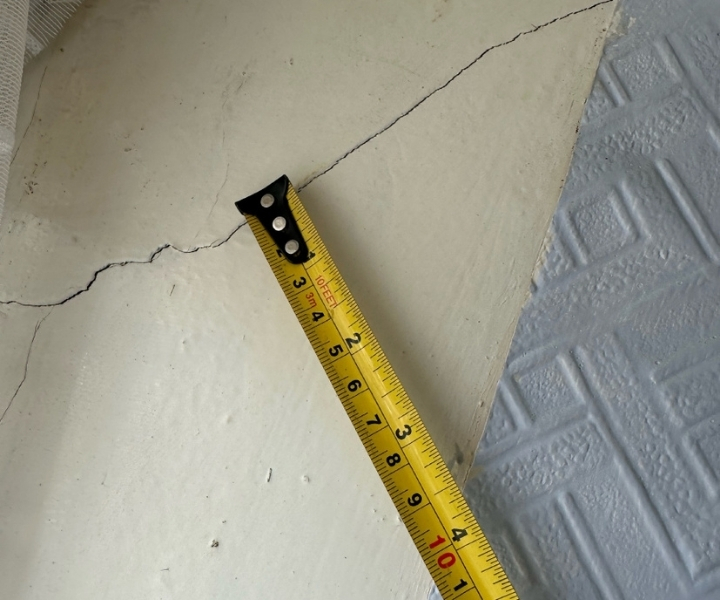Expert Crack Inspection; Safety starts with the right assessment
-
Spot the crack before they spread with Paramountbuilt expert crack inspection service in London.
-
Get a detailed report with honest advice from our certified surveyors.
-
Fast turnaround with accurate assessment and long term solutions.
-
Provide structural and architectural expertise you are looking for.
Professional House Crack Inspection Services in London

Cracks in walls, ceilings or floors may seem minor, but they could be warning signs of underlying structural issues. So it is always best to consider the precautions before it gets too late.
At Paramountbuilt, our professional house crack inspection services are designed to offer you the practical solutions. With a chartered team, we just don’t inspect, we diagnose the root cause and advise you on the safest, and most cost effective fix.
Our reports are accurate and helpful for the homeowners and buyers and can be used for insurance claims, and legal matters. So, don’t wait until a problem can become a crisis.
Ensure the Building's Safety with Professional Crack Inspection
Surface Cracks
Surface crack is one of the most common types or cracks that can be found in the buildings. They don’t seem serious, still they can become a threat to your building’s integrity. Our professionals will do the careful building crack inspection of the exterior and the interior of your property to detect the severity of the surface cracks.

Shrinkage Cracks
Shrinkage cracks appear due to moisture loss and contraction of building materials like cement and mortar. While these fractures may be faint and shallow at first, they become larger over time if not handled. Our inspection services will assess the impact of shrinkage cracks and suggest relevant corrective actions.

Settlement Cracks
Settlement cracks occur as the foundation of a structure settles unevenly. A range of underlying issues like substandard soil conditions, overloading, or vibration can trigger this. These cracks can develop into a serious issue as they can cause irreversible damage to the property’s structure. Our team will provide a comprehensive evaluation of your property’s foundation for any signs of settlement and offer professional building advice.

Non-Structural Cracks
Non-structural cracks are cracks that do not affect the operational functionality of a building. In most cases, these cracks result from settling or shrinking, or from the thermal expansion and contraction of constituent materials. We provide inspection services which include evaluation of non-structural cracks and provide appropriate repair options.

Mortar Crack
Mortar cracks are cracks that occur in the mortar joints, that is, the space in mortar containing the bricks or blocks. These cracks may stem from a number of reasons such as settlement, poor-grade mortar, high moisture levels, etc. Our experts will analyze the state of mortar joints and suggest adequate repair or repointing works.

Vertical Cracks
This set of cracks encompasses those that run upward or downward parallel to the length of the building. They may result from various factors such as settlement, issues with the foundation, or even problems of a more severe nature within structural elements. With so much experience in this area, our inspectors will thoroughly inspect your building’s walls and ceilings for vertical cracks and evaluate the severity as well as the possible reasons for their occurrence.

Horizontal Cracks
This type of cracks include those around the middle section of the wall of the building horizontally referred to as the ceiling. Horizontal cracks in walls or ceilings of a building can often indicate defects in structural foundations. Our chartered inspectors will examine your building for precise horizontal cracks along the walls and ceilings determining boundaries set as responsible for these fractures.

Diagonal Cracks
Diagonal cracks are defined as cracks which cut diagonal crosswise on a wall of a building. Our professionals are well versed with these kinds of damages and will perform complete assessment and provide repair suggestions for the identified diagonal cracks.

Structural Cracking
If not repaired on time, a deformity in structural cracking can lead to serious consequences for the building’s integrity. This issue is caused by settling of the building or weakening of the foundation; some other issues might include structural defects. If you think that your building has some deformities, our professional inspection will evaluate and diagnose along with structural cracks and provide suggestions on mitigation strategies.

How does crack inspection benefits you?

Define whether cracks are cosments or sign of serious structural moment

Receive easy to understand detailed reports

Spotting issues early prevent costly repairs later

Timely crack inspection reassure the buyers and add value to property

Use appropriate field verification techniques for accurate survey and reports
Get expert advice for precise crack inspection at Paramountbuilt.
Testimonials
What makes us the preferred choice for crack inspection?
New House Settling Cracks: Our RICS certified team can efficiently address all your new house crack problems.
Magnetic Crack Detection: Utilise advanced methods and techniques to detect the cracks that are non-destructive.
Ultrasonic Crack Detection: Use high frequency sound waves to detect and locate the cracks in materials.
FAQ’S
Qualified structural engineers or building surveyors are best suited to inspect and assess cracks in walls accurately and safely.
Structural cracks are usually wider than 3mm, appear diagonally, or follow a staircase pattern. This is where professional assistance becomes essential.
Only experienced structural engineers or certified building professionals should assess the cracks to determine whether they are cosmetic or serious.
Not always, some cracks are due to shrinkage or settlement, but significant ones could signal deeper structural issues needing inspection.
A typical on-site crack inspection can take 1 to 2 hours depending on the severity and the scope of the property.
Yes, visible and unassessed cracks can lower buyers confidence and property value unless inspected and reported by a professional.
